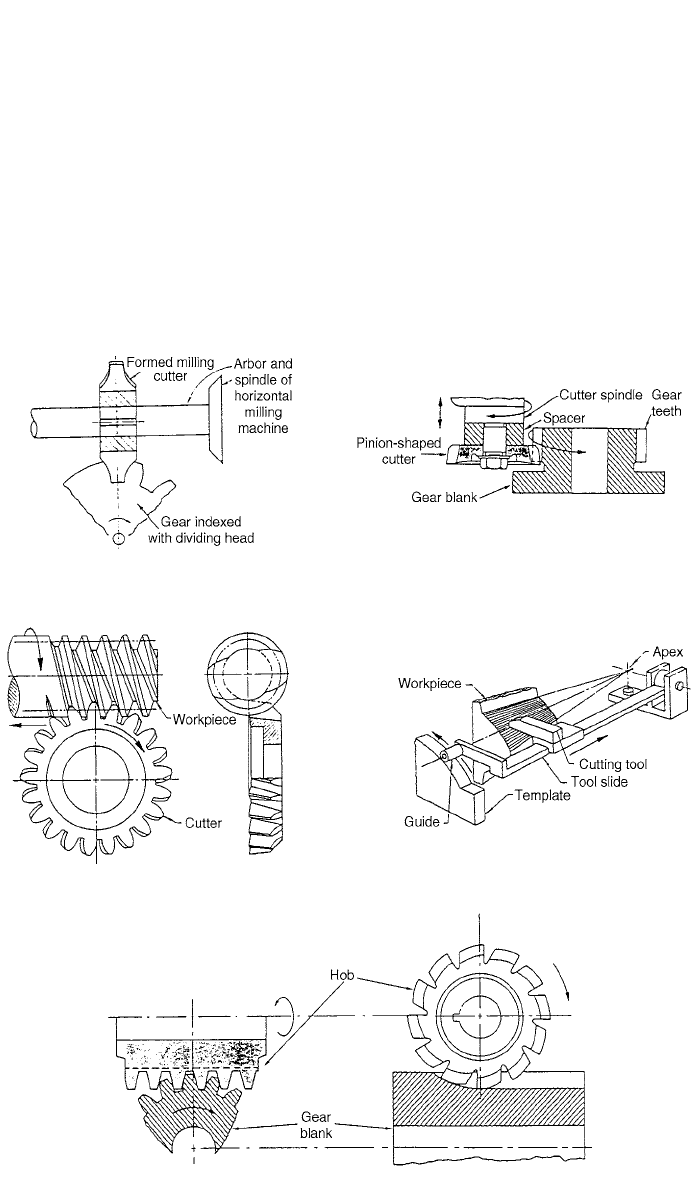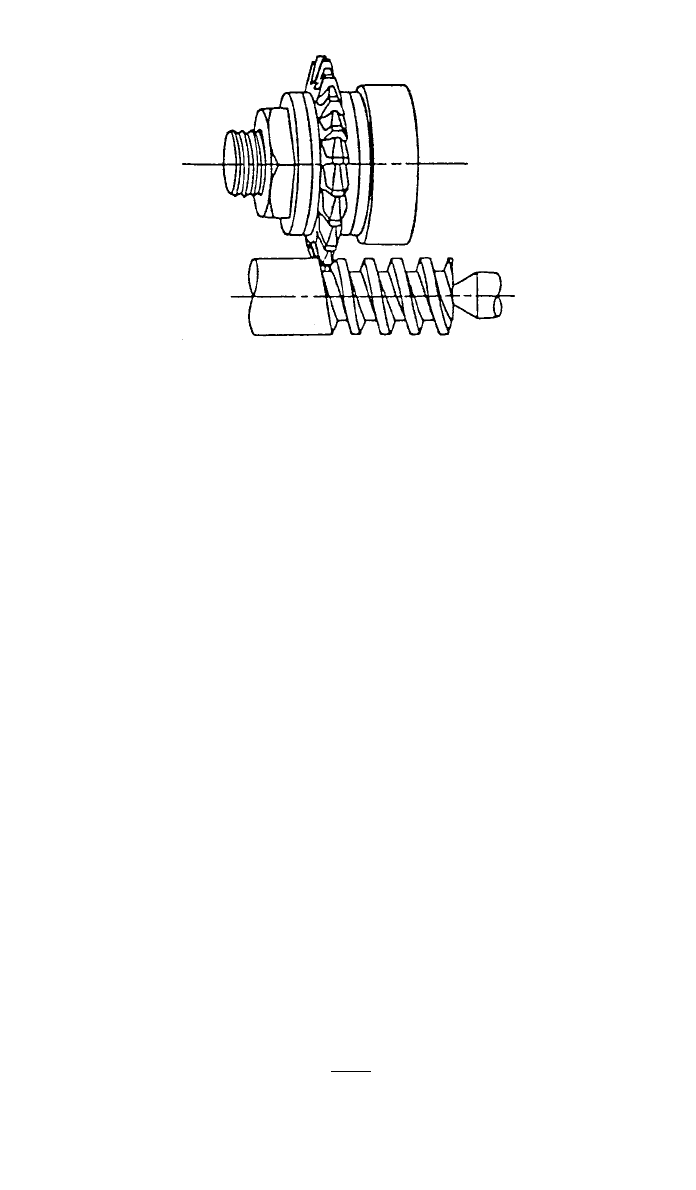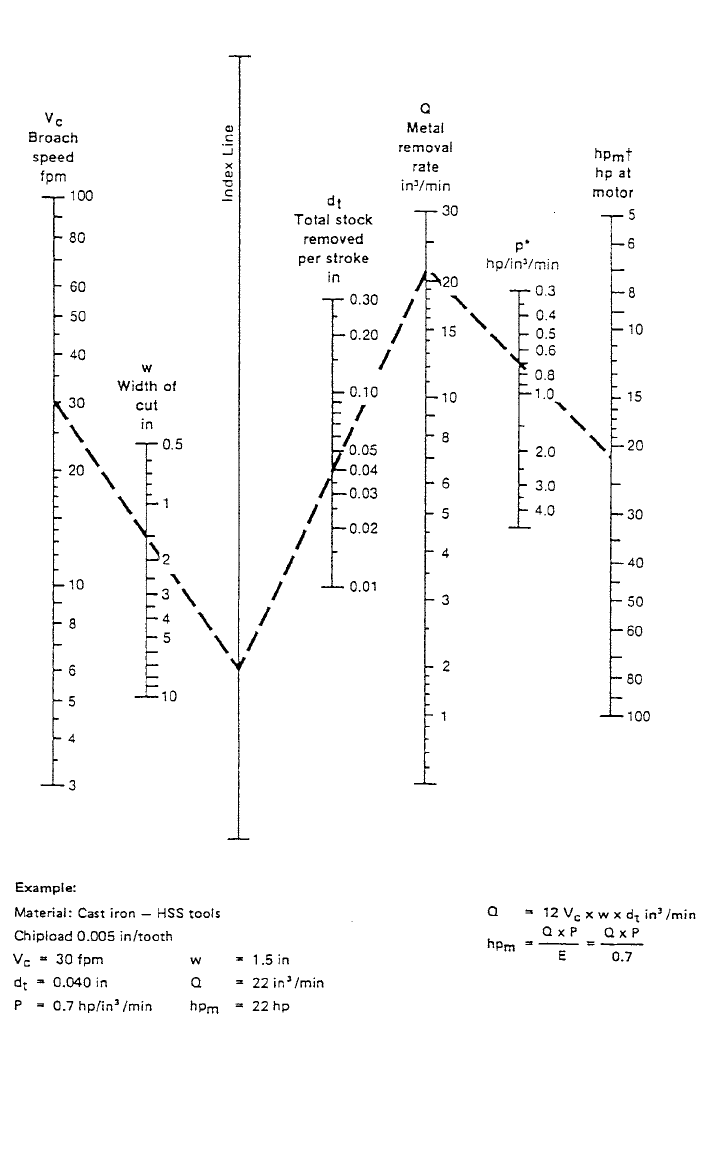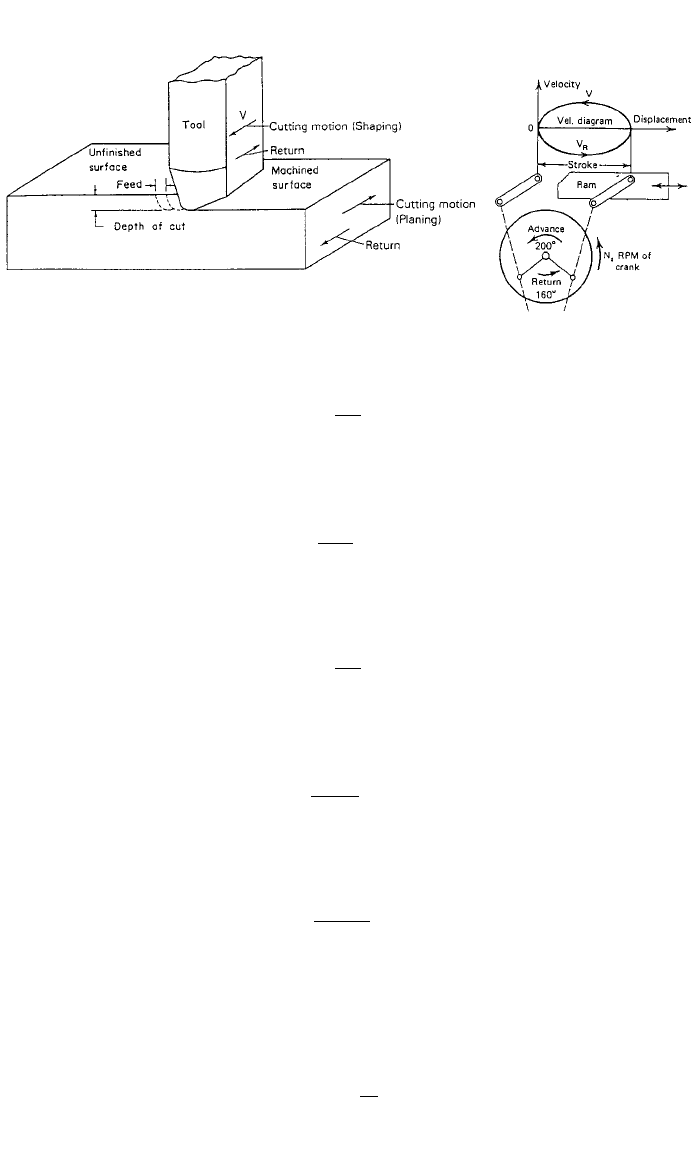Kutz M. Handbook of materials selection
Подождите немного. Документ загружается.


9 GEAR MANUFACTURING 883
Fig. 23 Machining gears.
method of producing gears of all types and sizes with high accuracy. Roll form-
ing can be used only on ductile materials; however, it has been highly developed
and widely adopted in recent years. Casting, powder metallurgy, extruding, roll-
ing, grinding, molding, and stamping techniques are used commercially in gear
production.
9.1 Machining Methods
There are three basic methods for machining gears.
Form cutting uses the principle illustrated in Fig. 23. The equipment and
cutters required are relatively simple, and standard machines, usually milling,

884 PRODUCTION PROCESSES AND EQUIPMENT FOR METALS
Table 12 Standard Gear Cutters
Cutter Number Gear Tooth Range
1 135 teeth to rack
2 55–34
3 35–54
4 26–34
5 21–25
6 17–20
7 14–16
8 12–13
are often used. Theoretically, there should be different-shaped cutters for each
size of gear for a given pitch, as there is a slight change in the curvature of the
involute. However, one cutter can be used for several gears having different
numbers of teeth without much sacrifice in their operating action. The eight
standard involute cutters are listed in Table 12. On the milling machine, the
index or dividing head is used to rotate the gear blank through a certain number
of degrees after each cut. The rule to use is: turns of index handle
⫽ 40/N,
where N is the number of teeth. Form cutting is usually slow.
Template machining utilizes a simple, single-point cutting tool that is guided
by a template. However, the equipment is specialized, and the method is seldom
used except for making large-bevel gears.
The generating process is used to produce most high-quality gears. This pro-
cess is based on the principle that any two involute gears, or any gear and a
rack, of the same diametral pitch will mesh together. Applying this principle,
one of the gears (or the rack) is made into a cutter by proper sharpening and is
used to cut into a mating gear blank and thus generate teeth on the blank. Gear
shapers (pinion or rack), gear-hobbing machines, and bevel-gear generating ma-
chines are good examples of the gear generating machines.
9.2 Gear Finishing
To operate efficiently and have satisfactory life, gears must have accurate tooth
profile and smooth and hard faces. Gears are usually produced from relatively
soft blanks and are subsequently heat-treated to obtain greater hardness, if it is
required. Such heat treatment usually results in some slight distortion and surface
roughness. Grinding and lapping are used to obtain very accurate teeth on hard-
ened gears. Gear-shaving and burnishing methods are used in gear finishing.
Burnishing is limited to unhardened gears.
10 THREAD CUTTING AND FORMING
Three basic methods are used for the manufacturing of threads; cutting, rolling,
and casting. Die casting and molding of plastics are good examples of casting.
The largest number of threads are made by rolling, even though it is restricted
to standardized and simple parts, and ductile materials. Large numbers of threads
are cut by the following methods:
1. Turning
2. Dies: manual or automatic (external)

10 THREAD CUTTING AND FORMING 885
Table 13 Recommended Tap-Drill Sizes for Standard Screw-
Thread Pitches (American National Coarse-Thread Series)
Number
or
Diameter
Threads
per
Inch
Outside
Diameter
of Screw
Tap Drill
Sizes
Decimal
Equivalent
of Drill
6 32 0.138 36 0.1065
8 32 0.164 29 0.1360
10 24 0.190 25 0.1495
12 24 0.216 16 0.1770
1
⁄
4
20 0.250 7 0.2010
3
⁄
8
16 0.375
5
⁄
16
0.3125
1
⁄
2
13 0.500
27
⁄
64
0.4219
3
⁄
4
10 0.750
21
⁄
32
0.6562
1 8 1.000
7
⁄
8
0.875
3. Milling
4. Grinding (external)
5. Threading machines (external)
6. Taps (internal)
10.1 Internal Threads
In most cases, the hole that must be made before an internal thread is tapped is
produced by drilling. The hole size determines the depth of the thread, the forces
required for tapping, and the tap life. In most applications, a drill size is selected
that will result in a thread having about 75% of full thread depth. This practice
makes tapping much easier, increases the tap’s life, and only slightly reduces
the resulting strength. Table 13 gives the drill sizes used to produce 75% thread
depth for several sizes of UNC threads. The feed of a tap depends on the lead
of the screw and is equal to 1/lead ipr.
Cutting speeds depend on many factors, such as
1. Material hardness
2. Depth of cut
3. Thread profile
4. Tooth depth
5. Hole depth
6. Fineness of pitch
7. Cutting fluid
Cutting speeds can range from lead 3 ft/min (1 m/min) for high-strength steels
to 150 ft/min (45 m/min) for aluminum alloys. Long-lead screws with different
configurations can be cut successfully on milling machines, as in Fig. 24. The
feed per tooth is given by the following equation:
dS
ƒ ⫽ (56)
t
nN

886 PRODUCTION PROCESSES AND EQUIPMENT FOR METALS
Fig. 24 Single-thread milling cutter.
where d ⫽ diameter of thread
n
⫽ number of teeth in cutter
N
⫽ rpm of cutter
S
⫽ rpm of work
10.2 Thread Rolling
In thread rolling, the metal on the cylindrical blank is cold-forged under con-
siderable pressure by either rotating cylindrical dies or reciprocating flat dies.
The advantages of thread rolling include improved strength, smooth surface fin-
ish, less material used (
⬃19%), and high production rate. The limitations are
that blank tolerance must be close, it is economical only for large quantities, it
is limited to external threads, and it is applicable only for ductile materials, less
than Rockwell C37.
11 BROACHING
Broaching is unique in that it is the only one of the basic machining processes
in which the feed of the cutting edges is built into the tool. The machined surface
is always the inverse of the profile of the broach. The process is usually com-
pleted in a single, linear stroke. A broach is composed of a series of single-
point cutting edges projecting from a rigid bar, with successive edges protruding
farther from the axis of the bar. Figure 25 illustrates the parts and nomenclature
of the broach. Most broaching machines are driven hydraulically and are of the
pull or push type.
The maximum force an internal pull broach can withstand without damage is
given by
AF
yy
P ⫽ lb (57)
s
where A
y
⫽ minimum tool selection, in.
2
F
y
⫽ tensile yield strength of tool steel, psi
s
⫽ safety factor

887
Fig. 25 Standard broach part and nomenclature.

888 PRODUCTION PROCESSES AND EQUIPMENT FOR METALS
The maximum push force is determined by the minimum tool diameter (D
y
),
the length of the broach (L), and the minimum compressive yield strength (F
y
).
The ratio L/D
y
should be less than 25 so that the tool will not bend under load.
The maximum allowable pushing force is given by
AF
yy
P ⫽ lb (58)
s
where F
y
is minimum compressive yield strength.
If L/D
y
ratio is greater than 25 (long broach), the Tool and Manufacturing En-
gineers Handbook gives the following formula:
74
5.6 ⫻ 10 D
r
P ⫽ lb (59)
2
sL
D
r
and L are given in inches.
Alignment charts were developed for determining metal removal rate (MRR)
and motor power in surface broaching. Figures 26 and 27 show the application
of these charts for either English or metric units.
Broaching speeds are relatively low, seldom exceeding 50 fpm, but, because
a surface is usually completed in one stroke, the productivity is high.
12 SHAPING, PLANING, AND SLOTTING
The shaping and planing operations generate surfaces with a single-point tool
by a combination of a reciprocating motion along one axis and a feed motion
normal to that axis (Fig. 28). Slots and limited inclined surfaces can also be
produced. In shaping, the tool is mounted on a reciprocating ram and the table
is fed at each stroke of the ram. Planers handle large, heavy workpieces. In
planing, the workpiece reciprocates and the feed increment is provided by mov-
ing the tool at each reciprocation. To reduce the lost time on the return stroke,
they are provided with a quick-return mechanism. For mechanically driven shap-
ers, the ratio of cutting time to return stroke averages 3:2, and for hydraulic
shapers the ratio is 2:1. The average cutting speed may be determined by the
following formula:
LN
CS ⫽ fpm (60)
12C
where N
⫽ strokes per minute
L
⫽ stroke length, in.
C
⫽ cutting time ratio, cutting time divided by total time
For mechanically driven shapers, the cutting speed reduces to

12 SHAPING, PLANING, AND SLOTTING 889
Fig. 26 Alignment chart for determining metal removal rate and motor horsepower in surface
broaching with high-speed steel broaching tools—English units.

890 PRODUCTION PROCESSES AND EQUIPMENT FOR METALS
Fig. 27 Alignment chart for determining metal removal rate and motor power in surface
broaching with high-speed steel broaching tools—metric units.

12 SHAPING, PLANING, AND SLOTTING 891
Fig. 28 Basic relationships of tool motion, feed, and depth of cut in shaping and planing.
LN
CS ⫽ fpm (61)
7.2
or
LN
1
CS ⫽ m/min (62)
600
where L
1
is the stroke length in millimeters. For hydraulically driven shapers,
LN
CS ⫽ fpm (63)
8
or
LN
1
CS ⫽ m/min (64)
666.7
The time T required to machine a workpiece of width W (in.) is calculated by
W
T ⫽ min (65)
N
⫻ ƒ
where ƒ
⫽ feed, in. per stroke
The number of strokes (S) required to complete a job is then
W
S ⫽ (66)
ƒ
The power required can be approximated by

892 PRODUCTION PROCESSES AND EQUIPMENT FOR METALS
HP ⫽ Kdƒ(CS) (67)
c
where d ⫽ depth of cut, in.
CS
⫽ cutting speed, fpm
K
⫽ cutting constant, for medium cast iron, 3; free-cutting steel, 6; and
bronze, 1.5 or
HP
⫽ 12ƒ ⫻ d ⫻ CS ⫻ HP
c
33,000 HP
c
F ⫽
c
CS
13 SAWING, SHEARING, AND CUTTING OFF
Saws are among the most common of machine tools, even though the surfaces
they produce often require further finishing operations. Saws have two general
areas of applications: contouring and cutting off. There are three basic types of
saws: hacksaw, circular, and band saw.
The reciprocating power hacksaw machines can be classified as either positive
or uniform-pressure feeds. Most of the new machines are equipped with a quick-
return action to reduce idle time.
The machining time required to cut a workpiece of width W in. is calculated
as follows:
W
T ⫽ min (68)
ƒN
where F
⫽ feed, in./stroke
N
⫽ number of strokes per min
Circular saws are made of three types: metal saws, steel friction disks, and
abrasive disks. Solid metal saws are limited in size, not exceeding 16 in. in
diameter. Large circular saws have either replaceable inserted teeth or seg-
mented-type blades. The machining time required to cut a workpiece of width
W in. is calculated as follows:
W
T ⫽ min (69)
ƒ nN
t
where ƒ
t
⫽ feed per tooth
n
⫽ number of teeth
N
⫽ rpm
Steel friction disks operate at high peripheral speeds ranging from
18,000–25,000 fpm (90–125 m/sec). The heat of friction quickly softens a path
through the part. The disk, which is sometimes provided with teeth or notches,
